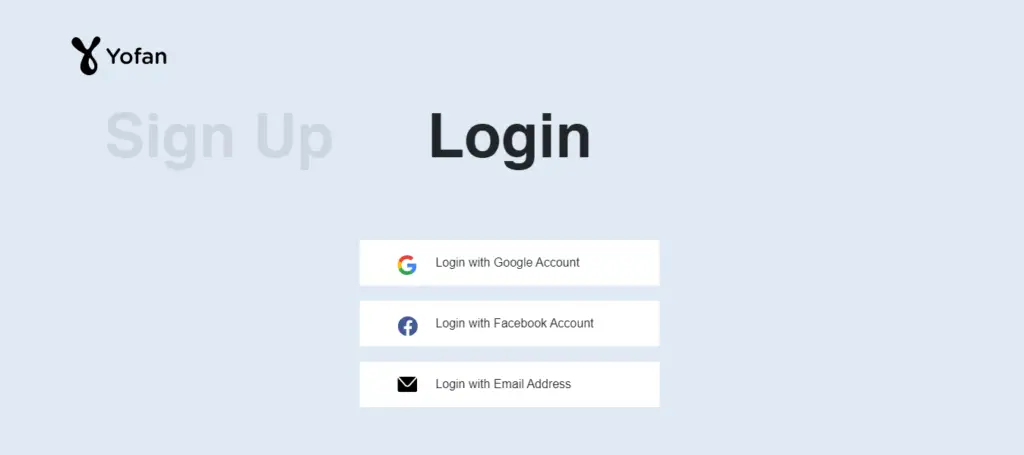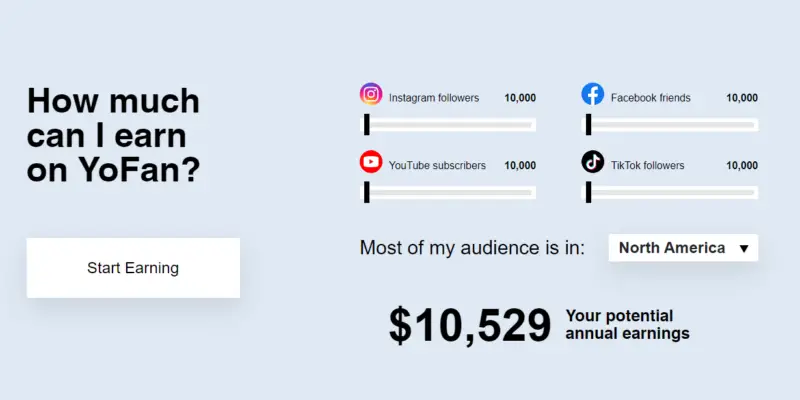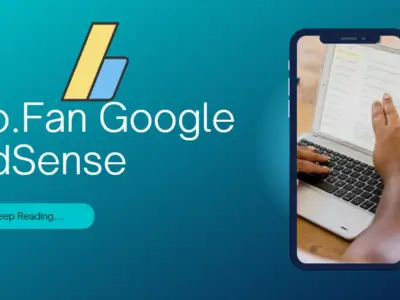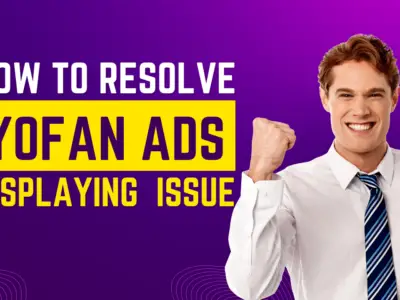When I initially ventured into online publishing and content creation, I aspired to establish a consistent revenue stream via online advertising. Google AdSense is the go-to choice for monetizing my websites and blogs, so I opted for it.
However, over time, I came to understand that there are alternatives to AdSense that not only match its performance but often surpass it significantly.
In this blog post, I’ll share my journey of exploring Yo.Fan alternatives, including some of the challenges and insights I gained. I’ll introduce you to ten Yo.Fan alternatives that have proven to be 10 times better when it comes to maximizing your ad revenue.
The Quest for Better Yo.Fan Alternatives

My journey towards seeking better alternatives to Yo.Fan started when I found my online ad revenue plateauing. Initially, I chose Yo.Fan with the expectation of boosting my income, but soon realized it wasn’t meeting my expectations.
This prompted me to seek alternative ad networks offering higher earnings and improved performance.
Personal Experience: The plateau in my Yo.Fan earnings was a wake-up call. I had put considerable time and effort into optimizing ad placements, experimenting with different ad formats, and trying various targeting options, all in an attempt to maximize my revenue.
However, despite these efforts, I found myself in a rut, with my income stagnating for months. It was clear that I needed to explore other options.
Why Seeking For Better Yo.Fan Alternatives?

The reasons for seeking better Yo.Fan alternatives were clear:
- Earnings Plateau: As mentioned, my Yo.Fan earnings had hit a plateau, and I was eager to find a platform that could offer more significant revenue potential.
- Diversification: Relying solely on Yo.Fan for ad revenue was risky. I understood that diversifying my revenue streams could provide a safety net in case of fluctuations or changes in Yo.Fan’s policies and performance.
- Performance Issues: I had noticed occasional performance issues with Yo.Fan, including slow-loading ads and occasional discrepancies in reporting. These issues made me question its reliability as my primary ad network.
- Market Competition: The online advertising landscape is competitive, with numerous ad networks vying for publishers’ attention. It seemed logical to explore what else was available in the market and see if there were networks better suited to my content and audience.
- Evolving Needs: My website’s content and audience have evolved, and I wanted an ad network that could adapt to these changes and provide better-targeted ads for my visitors.
With these motivations in mind, I set out to research and experiment with alternative ad networks that had the potential to outperform Yo.Fan. This journey ultimately led me to discover a range of alternatives that not only matched Yo.Fan’s performance often surpassed it, both in terms of revenue and overall user experience.
In the next section of this blog post, I will introduce you to these alternatives, sharing my experiences and insights to help you make informed decisions about which network might fit your online content and objectives.
The quest for better alternatives to Yo.Fan proved to be a rewarding endeavor, and I’m excited to share the knowledge and options I’ve discovered.
10 AdSense Alternatives That Outshine Yo.Fan

1. Media.net
Media.net is known for its contextual ad technology, which matches ads to the content of your website. It’s an excellent choice if you want ads seamlessly blending with your content, resulting in higher user engagement and click-through rates (CTR). Plus, their account managers provide great support, ensuring you get the most out of your ads.
Personal Experience: Media.net was one of the first alternatives to AdSense that I tried. It specializes in contextual ads, making them highly relevant to my content. After integrating Media.net ads, I saw an immediate boost in revenue.
2. Ezoic
Ezoic is an AI-driven platform that helps you optimize your website’s ad placements and configurations. It conducts experiments to find the best-performing ad setups and continuously fine-tunes them. This hands-off approach allowed me to focus more on content creation while seeing my earnings grow steadily.
Personal Experience: Ezoic takes an innovative approach to ad optimization. It uses AI to test different ad layouts and configurations to maximize revenue. After integrating Ezoic, my ad revenue saw a significant increase within weeks.
3. PropellerAds
PropellerAds offers a variety of ad forms, including interstitials, native advertisements, and push notifications. It’s an excellent choice if you have a diverse, worldwide audience. The platform also provides real-time statistics, helping you track your earnings and optimize campaigns.
Personal Experience: PropellerAds is perfect for websites with a global audience. I noticed a substantial increase in earnings, especially from international traffic, after incorporating PropellerAds’ push notifications and native ads.
4. Adversal
Adversal is known for its competitive CPM rates, making it a preferred choice for many publishers. They also offer prompt payment processing, ensuring you receive your earnings on time. The platform’s user-friendly interface and dedicated support team make it easy to get started.
Personal Experience: Adversal’s high CPM rates and fast payment processing stood out. It became one of my top choices for monetizing websites with quality traffic.
5. Infolinks
Infolinks specializes in non-intrusive, in-text ads that appear as links within your content. They also provide in-frame ads that display relevant content in the margins of your webpage. These unconventional ad formats can help improve the user experience while boosting your revenue.
Personal Experience: Infolinks offers unique ad formats, such as in-text and in-frame ads, seamlessly blending with your content. These creative ad types increased my click-through rates and earnings.
6. RevContent
RevContent is a native advertising platform that focuses on delivering high-quality content recommendations. The visually appealing native ads blend seamlessly with your website’s design, increasing user engagement and click-through rates. It’s a great choice if you want to maintain a user-friendly interface while maximizing revenue.
Personal Experience: RevContent is my go-to platform for native advertising. Its visually appealing native ads integrate seamlessly with my site’s content, resulting in higher engagement and earnings.
7. Bidvertiser
Bidvertiser’s unique selling point is its competitive bidding system, allowing advertisers to bid for your ad space. This often results in higher earnings as advertisers compete to display their ads on your site. Bidvertiser also offers various ad formats to suit your website’s layout.
Personal Experience: Bidvertiser offers flexible ad formats, including banners, pop-unders, and sliders. Their competitive bidding system consistently brought in higher earnings compared to AdSense.
8. Sovrn (formerly VigLink)
Sovrn is a versatile platform that specializes in affiliate marketing for content creators. It automatically converts regular product links into affiliate links, earning you commissions on sales generated through those links. This feature is particularly valuable for websites that produce product reviews or recommendations.
Personal Experience: Sovrn’s primary strength lies in affiliate marketing. By converting regular links into affiliate links, I saw a significant boost in earnings from product recommendations.
9. Adsterra
Adsterra offers various ad formats, from traditional banners to less intrusive pop-unders and push notifications. This diversity allows you to experiment with different ad types and find the best for your audience. Plus, their robust targeting options help you tailor ads to specific demographics.
Personal Experience: Adsterra’s diverse ad formats, including pop-unders and push notifications, helped me diversify my ad revenue streams. It’s an excellent choice for websites targeting various demographics.
10. BuySellAds
BuySellAds serves as a marketplace connecting website owners with advertisers directly. You can set your ad prices and negotiate deals, giving you more control over your ad inventory. This platform can be highly profitable if you have a niche website with a dedicated audience.
Personal Experience: BuySellAds simplifies ad-selling by connecting you with advertisers directly. It’s an excellent option for a niche website with engaged users.
Choosing the Right Yo.Fan Alternative

Now that we’ve explored several AdSense alternatives that have the potential to outperform Yo.Fan, it’s time to dive into the critical process of choosing the right one for your needs. While each of these alternatives comes with its own unique strengths, there are several factors you should consider before making your decision.
1. Audience and Content Compatibility
First and foremost, consider your audience and the type of content you create. Different ad networks may perform better for specific niches or demographics. Here’s how to approach this:
- Audience Demographics: Analyze your audience’s demographics, interests, and location. Some ad networks specialize in certain niches or have better reach in specific regions, so align your choice with your audience.
- Content Type: The nature of your content matters. For example, if you produce video content, YouTube’s AdSense integration or other video-focused networks may be your best bet. Similarly, content that caters to a particular industry or niche may benefit from specialized ad networks.
Personal Experience: When I transitioned from a general blog to a niche-specific website, I noticed that certain ad networks performed significantly better due to their relevance to the niche audience.
2. Performance Metrics
To determine which Yo.Fan alternative is the right fit, you’ll want to consider key performance metrics, including:
- CPM (Cost Per Thousand Impressions): CPM reflects how much you earn per 1,000 ad impressions. A higher CPM indicates better revenue potential.
- CPC (Cost Per Click): CPC measures the earnings you receive per click on an ad. Higher CPC rates can translate into more revenue for each click.
- CTR (Click-Through Rate): The CTR statistic shows the percentage of viewers who click on an advertisement after viewing it. Better earnings are frequently correlated with a high CTR.
- Fill Rate: The fill rate indicates the percentage of ad requests filled with ads. A higher fill rate minimizes revenue loss due to unfilled ad spaces.
Personal Experience: I closely monitored these metrics as I experimented with various ad networks. It became evident that different networks excelled in specific areas. For instance, one network might have a high CPM but a lower CTR, while another offered a better CPC.
3. Ease of Integration
It’s important to consider how easily the chosen ad network can be integrated with your website or platform. This includes factors such as:
- Ad Code Implementation: Is the ad code easy to implement? Some networks offer straightforward integration with WordPress plugins or website builders, while others may require more technical expertise.
- Customization: Assess the level of customization available. Matching ad styles to your website’s design can enhance user experience.
- Responsive Design: Ensure the ad network supports responsive design, adapting ad formats to different screen sizes and devices.
Personal Experience: I found that ad networks offering user-friendly plugins and straightforward integration guides reduced the technical challenges and time required for implementation.
4. Ad Formats and User Experience
Consider how different ad formats may impact the user experience on your site. Balancing monetization with a positive user experience is crucial for retaining and growing your audience.
- Ad Placement Options: Look for networks that offer various ad placement options, including in-content, sidebar, header, and footer placements. This allows you to optimize your layout for both user experience and revenue.
- Ad Intrusiveness: Assess the intrusiveness of the ad formats. Highly intrusive ads may lead to user dissatisfaction and potentially harm your site’s reputation.
- Ad Relevance: Ensure the ad network’s targeting capabilities align with your content to deliver relevant ads to your audience.
Personal Experience: I’ve encountered situations where aggressive ad formats led to higher revenue initially but caused a decline in user engagement and site traffic over time. Finding the right balance is essential.
5. Reporting and Analytics
Access to robust reporting and analytics tools is vital for optimizing your ad strategy and understanding your audience’s behavior. Look for the following features:
- Real-time Reporting: Networks that provide real-time data can help you make informed decisions and respond to changing trends quickly.
- Data Segmentation: The ability to segment data by various dimensions, such as geography, device, and ad placement, can provide valuable insights.
- Conversion Tracking: If your goal is ad revenue and conversions (e.g., product sales or lead generation), consider whether the network supports conversion tracking.
Personal Experience: Access to detailed analytics allowed me to identify peak traffic times, high-performing ad placements, and user behavior trends, all contributing to better earnings.
6. Payment Terms and Thresholds
Review the payment terms of the ad network, including payment methods, thresholds, and frequency. Different networks have varying minimum payout amounts and payment schedules.
- Minimum Payout: Ensure the minimum payout threshold aligns with your earnings expectations. Some networks have low minimum payout requirements, while others require higher earnings before releasing payments.
- Payment Methods: Check the available payment methods (e.g., PayPal, wire transfer, or checks) and consider convenient options.
- Payment Frequency: Evaluate the frequency of payments (e.g., monthly, bi-monthly, or weekly) to ensure they match your cash flow needs.
Personal Experience: I’ve encountered situations where some ad networks had high minimum payout thresholds, making it challenging to access my earnings in a timely manner. Assessing whether the payment terms align with your financial goals is essential.
7. User Reviews and Reputation
Research the ad network’s reputation and user reviews. Seek feedback from other publishers who have experience with the network to gain insights into their experiences, reliability, and support.
- Online Forums and Communities: Explore online forums and communities where publishers share their experiences with different ad networks.
- Publisher Testimonials: Some ad networks provide testimonials or case studies from satisfied publishers, which can offer valuable insights.
- Customer Support: Assess the quality and responsiveness of the network’s customer support. Reliable support can be crucial when facing technical issues or needing assistance.
Personal Experience: I’ve found that reading user reviews and engaging with fellow publishers in online communities provided invaluable perspectives that helped me make informed decisions.
8. Experimentation and A/B Testing
Remember that the best Yo.Fan alternatives for your website may not be the same as for someone else’s. It’s essential to be open to experimentation and A/B testing to identify the network that maximizes your revenue.
- A/B Testing: Conduct A/B tests by running different ad networks simultaneously on different pages or sections of your website. Compare their performance and earnings.
- Periodic Reevaluation: The online advertising landscape is dynamic, with networks frequently updating their features and algorithms. Periodically reevaluate your choice to ensure it still aligns with your goals.
Personal Experience: A/B testing allowed me to make data-driven decisions and discover which network performed best for specific content categories and audience segments.
Making the Switch To Your New Yo.Fan Alternative

Switching from Yo.Fan to a new ad network can significantly increase your ad revenue and improve your overall monetization strategy. However, making this transition as smooth as possible is important to minimize disruptions to your website or blog. This chapter will provide a detailed guide on effectively making the switch.
1. Sign Up and Prepare
Before making the switch, you’ll need to sign up with the new ad network of your choice. Here’s what you should consider during this phase:
- Account Creation: Register for an account with the new ad network. Follow their registration process, which may include providing information about your website, audience, and preferred ad formats.
- Approval Process: Some ad networks have approval requirements, which may take some time to get accepted. Be prepared to meet their criteria and provide any necessary documentation.
- Ad Code Generation: The ad network will provide ad codes or scripts once approved. These codes are what you’ll integrate into your website to display ads.
- Backup Your Existing Setup: Before making any changes, it’s crucial to back up your current Yo.Fan ad setup. This includes saving your existing ad codes, placements, and any customizations you’ve made.
2. Integration and Testing
Once you have access to the new ad network’s ad codes, it’s time to integrate them into your website and start testing. Here’s how to go about it:
- Ad Placement: Carefully integrate the new ad codes into your website. Follow the ad network’s guidelines for ad placement to ensure optimal performance. This may involve replacing existing Yo.Fan ad codes or adding new placements.
- Page Speed Optimization: Ensure the new ads do not negatively impact your website’s loading speed. Monitoring page speed is crucial for both user experience and SEO.
- Testing Phase: Implement the new ads alongside your existing Yo.Fan ads for a testing period. This enables you to evaluate performance and verify that the new network performs as promised.
- During the testing phase, it is crucial to closely monitor performance metrics. Track key indicators like CPM (Cost Per Thousand Impressions), CPC (Cost Per Click), click-through rates (CTR), and overall revenue. Compare these metrics to your Yo.Fan performance.
3. Evaluate and Optimize
After running the new ads alongside Yo.Fan for a sufficient testing period (usually a few weeks), it’s time to evaluate the results and optimize your setup:
- Performance Comparison: Analyze the performance data to determine how the new ad network performs compared to Yo.Fan. Look for significant improvements in revenue and user engagement.
- A/B Testing: Consider conducting A/B tests where you switch off Yo.Fan ads for specific periods to assess the impact on revenue. This can help you gauge the true performance of the new network.
- User Feedback: Gather feedback from your audience. Are they noticing any changes in the ads? Is the user experience improving or declining? User feedback can provide valuable insights.
- Optimization: Based on the data and feedback, make necessary adjustments to your ad placements, ad formats, and targeting options. Continuously optimize to maximize revenue without compromising user experience.
4. Full Transition
Once you are satisfied with the performance of the new ad network and have optimized your setup, you can proceed with the full transition:
- Replace Yo.Fan Ads: Gradually replace all Yo.Fan ad codes with the new network’s ad codes across your website. Ensure that every instance of Yo.Fan ads is updated to display the new network’s ads.
- Testing After Transition: Monitoring ad performance closely after the transition is complete. Verify that all ads are displaying correctly and have no technical issues.
- Backup Yo.Fan Configuration: Keep a backup of your Yo.Fan configuration and ad codes in case you ever need to revert to Yo.Fan or encounter any unforeseen issues with the new network.
5. Compliance and Terms
Remember to review and adhere to the new ad network’s policies and terms of service. Maintain up-to-date knowledge of any modifications or changes to their policies to prevent infringements that can result in problems with your account.
6. Payment Setup
Ensure you’ve set up your payment information correctly with the new ad network. This includes providing accurate banking details or payment preferences. Verify payment schedules and thresholds to ensure you receive your earnings promptly.
7. Monitor and Fine-Tune
The transition to a new ad network is not a one-time event; it’s an ongoing process. Here are some essential steps to follow post-transition:
- Regular Monitoring: Monitor ad performance, user feedback, and page speed to ensure everything runs smoothly.
- Optimization: Optimize your ad setup based on performance data and user feedback. Implement changes as needed to maintain or improve revenue.
- Stay Informed: Keep yourself updated on industry trends and changes in the online advertising landscape. This will help you adapt to new opportunities and challenges.
- Seek Support: If you encounter technical issues or need assistance with the new network, don’t hesitate to contact their support team for guidance.
By following these steps and approaching the transition methodically, you can effectively switch from Yo.Fan to a new ad network while minimizing disruptions and maximizing your ad revenue potential. Every website is unique, so be prepared to adapt your strategy based on your specific audience and content.
Conclusion: Choosing Yo.Fan Alternatives
Choosing the best Yo.Fan alternative is a crucial decision that can significantly impact your online ad revenue. By carefully considering factors such as audience compatibility, performance metrics, ease of integration, ad formats, reporting tools, payment terms, reputation, and a willingness to experiment, you can make an informed choice that aligns with your website’s goals and objectives.
Remember that the ideal alternative may evolve as your content, audience, and the advertising landscape change. Stay proactive, continue to monitor performance, and be ready to adapt your ad strategy to maximize your earnings and provide the best possible user experience for your visitors.
Discover more from Digital Wealth Guru
Subscribe to get the latest posts sent to your email.









Comments